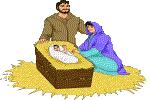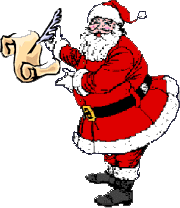![]()
CHRISTMAS
![]()
 THE HISTORY OF THE CHRISTMAS TREE
THE HISTORY OF THE CHRISTMAS TREE
CHRISTMAS TREE TRADITION HAS ANCIENT ORIGINS
King Tut never saw a Christmas tree, but he
would have understood the tradition which traces back long before the first
Christmas, says David Robson, Extension Educator, Horticulture with the
The Egyptians were part of a long line of cultures that treasured and worshipped evergreens. When the winter solstice arrive, they brought green date palm leaves into their homes to symbolize life's triumph over death.
The Romans celebrated the winter solstice with a fest called Saturnalia in honor of Saturnus, the god of agriculture. They decorated their houses with greens and lights and exchanged gifts. They gave coins for prosperity, pastries for happiness, and lamps to light one's journey through life.
Centuries ago in
Late in the Middle Ages, Germans and Scandinavians placed evergreen trees inside their homes or just outside their doors to show their hope in the forthcoming spring. Our modern Christmas tree evolved from these early traditions.
Legend has it that Martin Luther began the tradition of decorating trees to celebrate Christmas. One crisp Christmas Eve, about the year 1500, he was walking through snow-covered woods and was struck by the beauty of a group of small evergreens. Their branches, dusted with snow, shimmered in the moonlight. When he got home, he set up a little fir tree indoors so he could share this story with his children. He decorated it with candles, which he lighted in honor of Christ's birth.
The Christmas tree tradition most likely came
to the
But the custom spread slowly. The Puritans
banned Christmas in
The Christmas tree market was born in 1851
when Catskill farmer Mark Carr hauled two ox sleds of evergreens into
Christmas tree farms sprang up during the depression. Nurserymen couldn't sell their evergreens for landscaping, so they cut them for Christmas trees. Cultivated trees were preferred because they have a more symmetrical shape then wild ones.
Six species account for about 90 percent of the nation's Christmas tree trade. Scotch pine ranks first, comprising about 40 percent of the market, followed by Douglas fir which accounts for about 35 percent. The other big sellers are noble fir, white pine, balsam fir and white spruce.
by: David Robson Extension Educator,
![]()
 THE HISTORY OF CHRISTMAS TREE ORNAMENTS
THE HISTORY OF CHRISTMAS TREE ORNAMENTS
It is from
How these traditions traveled to
The tree that Price Albert provided his
family was admired by all in
A F.W. Woolworth brought the glass ornament
tradition to the
During the hay
day of turn of the century ornament making, almost all ornaments were made in
Lauscha, a small town nested in the Thuringian mountains. After the war,
however, glass ornament production declined. Many of the craftsmen left for
In the 1960's it was fashionable to have an Aluminum tree and all the same
shape and color ornaments. Many threw away the old ornaments from
![]()
Origins of Christmas
Saint Boniface and The Christmas Tree
Saint Boniface, an English missionary, known as the "Apostle of Germany", in 722 came upon some men about to cut a huge oak tree as a stake (Oak of Thor) for a human sacrifice to their pagan god. With one mighty blow, Saint Boniface felled the massive oak and as the tree split, a beautiful young fir tree sprang from its center. Saint Boniface told the people that this lovely evergreen, with its branches pointing to heaven, was indeed a holy tree, the tree of the Christ Child, a symbol of His promise of eternal life. He instructed them henceforth to carry the evergreen from the wilderness into their homes and to surround it with gifts, symbols of love and kindness.
Saint Boniface (feast June 5) received the name Winfrid at his baptism but took the name Boniface before he was ordained to the priesthood. He was martyred at the age of 75.
![]()
The Paradise
Tree
There is a very old and charming European custom of decorating a fir tree with apples and small white wafers representing the Holy Eucharist. These wafers were later replaced by little pieces of pastry cut in the shapes of stars, angels, hearts, flowers, and bells. Eventually other cookies were introduced bearing the shapes of men, birds, roosters and other animals.
In the Middle Ages, about the 11th century,
religious theater was born. One of the most popular plays, the German mystery
play, concerned Adam and Eve, their fall and expulsion from the Garden of
Eden--from the Early Paradise. The Garden of Eden was represented by a fir tree
hung with apples. It represented both the Tree of Life and the Tree of
Discernment of Good and Evil which stood in the center of
The one piece of scenery--the
"Paradeisbaum (the Paradise Tree) became a popular object, and was often
set up in churches, and eventually in private homes as well. It became a symbol
of the Savior. Since the tree represented not only
The German and English immigrants brought the
Christmas tree to
![]()
The Legend of the Pine Tree
When the Holy family was pursued by Herod's soldiers, many plants offered them shelter. One such plant was the Pine Tree. When Mary was too weary to travel longer the family stopped at the edge of a forest to rest. A gnarled old pine which had grown hollow with its' years invited them to rest within its trunk--then it closed its branches down and kept them safe until the soldiers had passed. Upon leaving, the Christ Child blessed the pine and the imprint of his little hand was left forever in the tree's fruit--the pine cone. If a cone is cut lengthwise the hand may still be seen.
![]()
The Origin of Christmas Cards
The Christmas card is a Victorian creation,
which began as a kind of stationery. The first card was produced by Sir Henry
Cole who worked for the British Postal Service, and an artist he hired named
John Calcott Horsley. This early card was a depiction of a Christmas scene
framed in three panels. In the center panel was a homey table scene: children,
parents and grandparents seated and some raising their glasses for a toast. On
either side were panels depicting acts of Christmas charity: to the left,
feeding the hungry; to the right, clothing the naked. Underneath appears the
now familiar phrase "A Merry Christmas and a Happy New Year to You."
Actually cards were preceded by "Christmas Pieces" written by school
boys in
![]()
The Date of
Christmas
 The idea to celebrate Christmas on December 25
originated in the 4th century. The Catholic Church wanted to eclipse the
festivities of a rival pagan religion that threatened Christianity's existence.
The Romans celebrated the birthday of their sun god, Mithras during this time
of year. Although it was not popular, or even proper, to celebrate people's birthdays
in those times, church leaders decided that in order to compete with the pagan
celebration they would themselves order a festival in celebration of the birth
of Jesus Christ. Although the actual season of Jesus' birth is thought to be in
the spring, the date of December 25 was chosen as the official birthday
celebration as Christ's Mass so that it would compete head on with the rival
pagan celebration. Christmas was slow to catch on in
The idea to celebrate Christmas on December 25
originated in the 4th century. The Catholic Church wanted to eclipse the
festivities of a rival pagan religion that threatened Christianity's existence.
The Romans celebrated the birthday of their sun god, Mithras during this time
of year. Although it was not popular, or even proper, to celebrate people's birthdays
in those times, church leaders decided that in order to compete with the pagan
celebration they would themselves order a festival in celebration of the birth
of Jesus Christ. Although the actual season of Jesus' birth is thought to be in
the spring, the date of December 25 was chosen as the official birthday
celebration as Christ's Mass so that it would compete head on with the rival
pagan celebration. Christmas was slow to catch on in
n
 Mistletoe and Holly
Mistletoe and Holly
 Poinsettias
Poinsettias
Poinsettias
are native to
 The Christmas Tree
The Christmas Tree
Xmas
This
abbreviation for Christmas is of Greek origin. The word for Christ in Greek is
Xristos. During the 16th century, Europeans began using the first initial of
Christ's name, "X" in place of the word Christ in Christmas as a
shorthand form of the word. Although the early Christians understood that X
stood for Christ's name, later Christians who did not understand the Greek
language mistook "Xmas" as a sign of disrespect. ~ The
Greek letter "X" is the equivalent of CH and is also a symbol of
Christ which explains the spelling "XMAS".
Santa Claus The
year 1841 was a significant year in the Christmas celebration in
The
year 1841 was a significant year in the Christmas celebration in
n The
green tree has significant importance almost all over the world. In